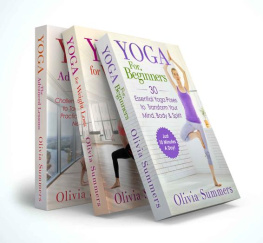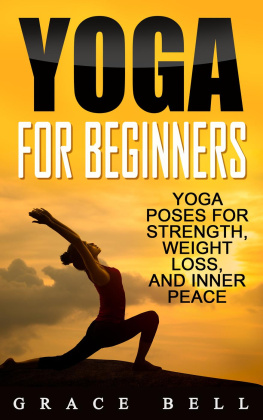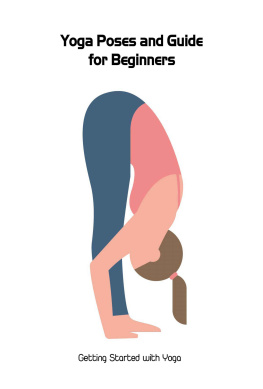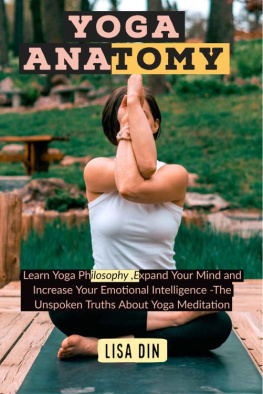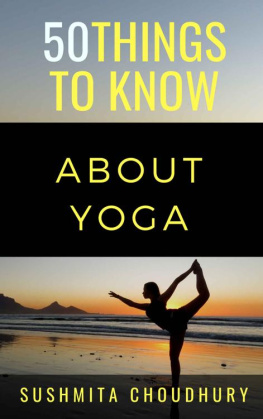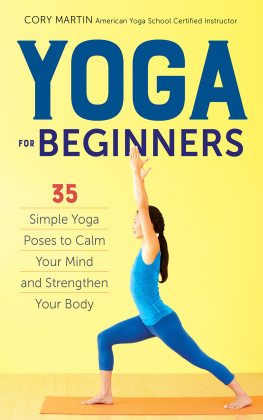Yoga Mastery Series
Box Set #1
Yoga for Beginners, Weight Loss & The Advanced Lessons
Olivia Summers
Copyright 2016 by Olivia Summers
All rights reserved. This book or any portion thereof may not be reproduced or used in any manner whatsoever without the express written permission of the publisher except for the use of brief quotations in a book review or scholarly journal.
Disclaimer: Although the author and publisher have made every effort to ensure that the information in this book was correct at press time, the author and publisher do not assume and hereby disclaim any liability to any party for any loss, damage, or disruption caused by errors or omissions, whether such errors or omissions result from negligence, accident, or any other cause.
This book is not intended as a substitute for the medical advice of physicians. The reader should regularly consult a physician in matters relating to his/her health and particularly with respect to any symptoms that may require diagnosis or medical attention.
Table of Contents
Yoga For Beginners
30 Essential Yoga Poses to Transform Your
Mind, Body & Spirit
Learn Yoga in Just 10 Minutes a Day
Olivia Summers
Introduction
Thank you so much for purchasing my book Yoga For Beginners. My name is Olivia Summers and Im a Certified Yoga Teacher and for the duration of this book Im going to personally be by your side coaching you along for the next 30 days.
One thing Id like to point out, though, is that the time frame I use is just a starting off point. You can spend as much time as youd like on each pose. In the book I suggest just 10 minutes as youre starting point and thats perfectly acceptable. You will gain a much better perspective of yoga just by committing to that amount of time each day. However, if you really want to boost your practice and flexibility, I would suggest spending as many days as youd like on each pose until you feel like youve got it. For some people this might be a few days, for others it may just be 10 minutes.
Another suggestion Id like for you to keep in mind as you move through each day on your journey, is that if you really want to cut down on your learning curve and the time it takes you to go from newbie to advanced is to practice each yoga pose that youve learned up until this point.
For instance, if youre on Day 4, start your practice with the poses from Day 1, Day 2, Day 3 and so on. This will keep the poses fresh in your mind and also work more parts of your body. Once you get to Day 30 youll have an entire workout at your disposal.
Again, thank you for downloading my book and I hope that it helps you to have a better understanding of what yoga is and how it fits into your life. And who knows, maybe youll love it just as much as I do!
Chapter 1: Yoga 101
Where Did Yoga Come From?
If youre like most people just starting out on their yoga journey then Im sure you have lots of questions. And well get to those, I promise. First, though, Id like to give you a very brief history of the origins of yoga and summarize how it came to be the yoga we all know and love today.
Yoga is actually a philosophy that came into practice in India about 5,000 years ago! Although it is sometimes part of practicing Buddhism and Hinduism, yoga in and of itself is not a religion.
The founding father of ashtanga yoga and author of the Yoga Sutras was Patanjali. Unfortunately, very little is known about who he was or where he came fromor even when exactly he lived. One thing is certain, thoughif Patanjali had not completed his Yoga Sutras we probably wouldnt know much, if anything, about the yoga we practice today. Patanjalis Sutras were a collection of 195 different philosophies about the practice of yoga. His book also outlined the eight individual limbs or types of yogaasana (postures) being the most popular in Western culture.
In the late 19 th and early 20 th centuries many of the yoga gurus from India introduced yoga as a practice to Western civilization. However, it wasnt until around the 1980s that yoga became a more popular form of physical exercise in the Western world.
Many serious yoga practitioners and gurus frown upon our commercialized version of yoga in the United States. The reason for this is because they believe that yoga is meant to be much more than just exercise. Its traditional roots are founded in meditative and spiritual upbringingbecoming in tune to oneself in the process.
I agree with these gurus and in my personal practice I use yoga for spiritual and meditative purposes. However, everyone has to start somewhere. And if you just want to have fun, increase your flexibility and learn some poses along the way I think thats wonderful!
I dont think that yoga needs to be a strict set of standards that only a few people here and there are worthy of experiencing. I think that no matter where you start from, as long as you do, youre going to be better off.
Main Types of Yoga
Aerial Basically this is yogain a hammock! Aerial yoga was introduced in New York and is one of the newest forms of yoga. If youre the adventurous type and already have the more run-of-the-mill yoga classes under your belt then it might be time for you to give this a try.
Ashtanga This is one of the oldest forms of yoga (remember Patanjalis Sutras ?) and what well be using throughout this book. Ashtanga is made up of six different series of postures and is used prevalently throughout the West.
Bikram Bikram yoga was introduced and made popular in the 1970s. Most people looking to lose weight and torch calories during a yoga session turn to Bikram yoga. Its also known as hot yogaand for good reason. The classes are 90 minutes long and consist of a series of 26 poses that are repeated twice during the session. The catch? The room is heated to 104F and a humidity of 40%!
Hatha Hatha yoga is what all other types of yoga are founded on and uses a more holistic approach than newer variations of yoga. It is a combination of meditation, purification, breathing and postures. It is very gentle and is great for beginners.
Kundalini This can be one of the most fun forms of yoga, in my opinion. Kundalini yoga is founded on the belief that there is latent energy coiled at the base of our spines and it needs to be released. Kundalini yoga uses meditation and breathing to activate your chakras and release built up energy.
Restorative This one is pretty self-explanatory. This type of yoga is focused on using different props to restore your physical body with your mental state. Its a very gentle and relaxing form of yoga. It is especially beneficial to those who need to learn to slow down and relieve stress.
Vinyasa The term Vinyasa originates from the Sanskrit language and actually means breath-synchronized movement. Which is exactly what youre doing during this type of yoga. You move through a series of poses while at the same time using your exhaling and inhaling breaths to dance your way through each pose. It is also sometimes referred to as Vinyasa Flow.
Feel free to experiment and play around with the different types of yoga and find the one that feels best to you. Just because something is deemed intermediate or advanced doesnt mean you cant try it out. You dont have to limit yourself to beginner types of yoga.
The best thing you can do to figure out where you belong in the yoga world is to find a gym or yoga studio that offers bundlesthat way you can sample different classes to find the one that fits you best.
Chapter 2: But Im Not Flexible
As a yoga instructor, this is one of the biggest hesitations and objections I hear when it comes to trying yogaIm not flexible.
Well, Im here to tell you that that is perfectly okay! In fact, its a wonderful reason to start practicing yoga. Do you think that when I first started out I was a super-bendy obscenely flexible human being? I definitely wasnt. I was actually the opposite and it took me almost a year to feel flexible. Either way, dont be discouraged. Everyone is different and just go at your own pace.

